Financial Accounting: Disclosure Principles and Journal Entry Tasks
VerifiedAdded on 2023/06/15
|18
|3771
|380
Homework Assignment
AI Summary
This assignment solution addresses key aspects of financial accounting, beginning with a letter to the IASB providing feedback on disclosure principles, specifically concerning the annual reports of Commonwealth Bank (CBA) and National Australia Bank (NAB). It identifies issues such as irrelevant information, insufficient disclosure, and ineffective communication, recommending improvements in data presentation, formatting, and entity-specific information. The solution also includes journal entries for Beach Supplies Ltd., detailing transactions related to share issuance, underwriting, and forfeiture. Furthermore, it provides a worksheet for current and deferred tax liabilities, calculating taxable income, tax losses, and temporary differences arising from depreciation and provisions.
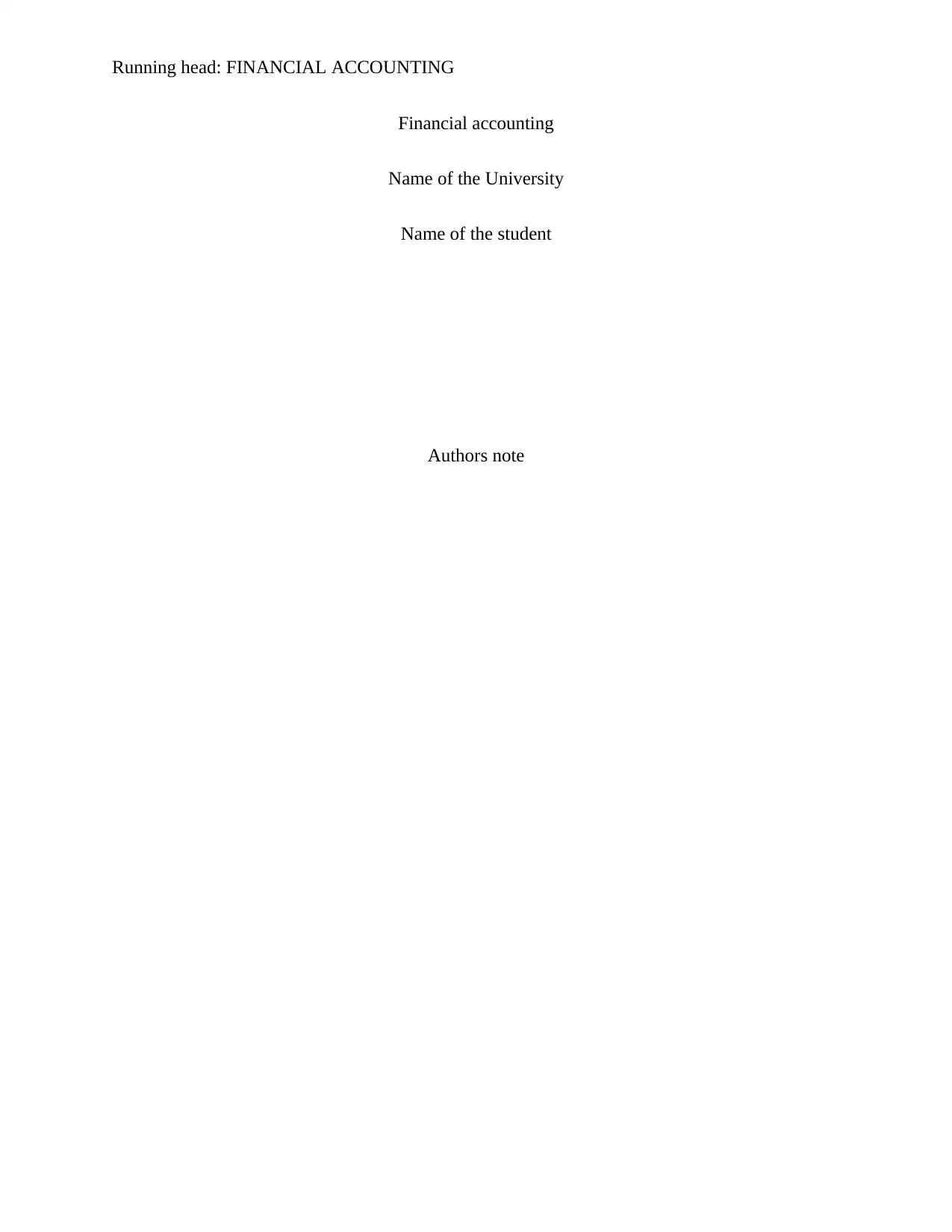
Running head: FINANCIAL ACCOUNTING
Financial accounting
Name of the University
Name of the student
Authors note
Financial accounting
Name of the University
Name of the student
Authors note
Secure Best Marks with AI Grader
Need help grading? Try our AI Grader for instant feedback on your assignments.
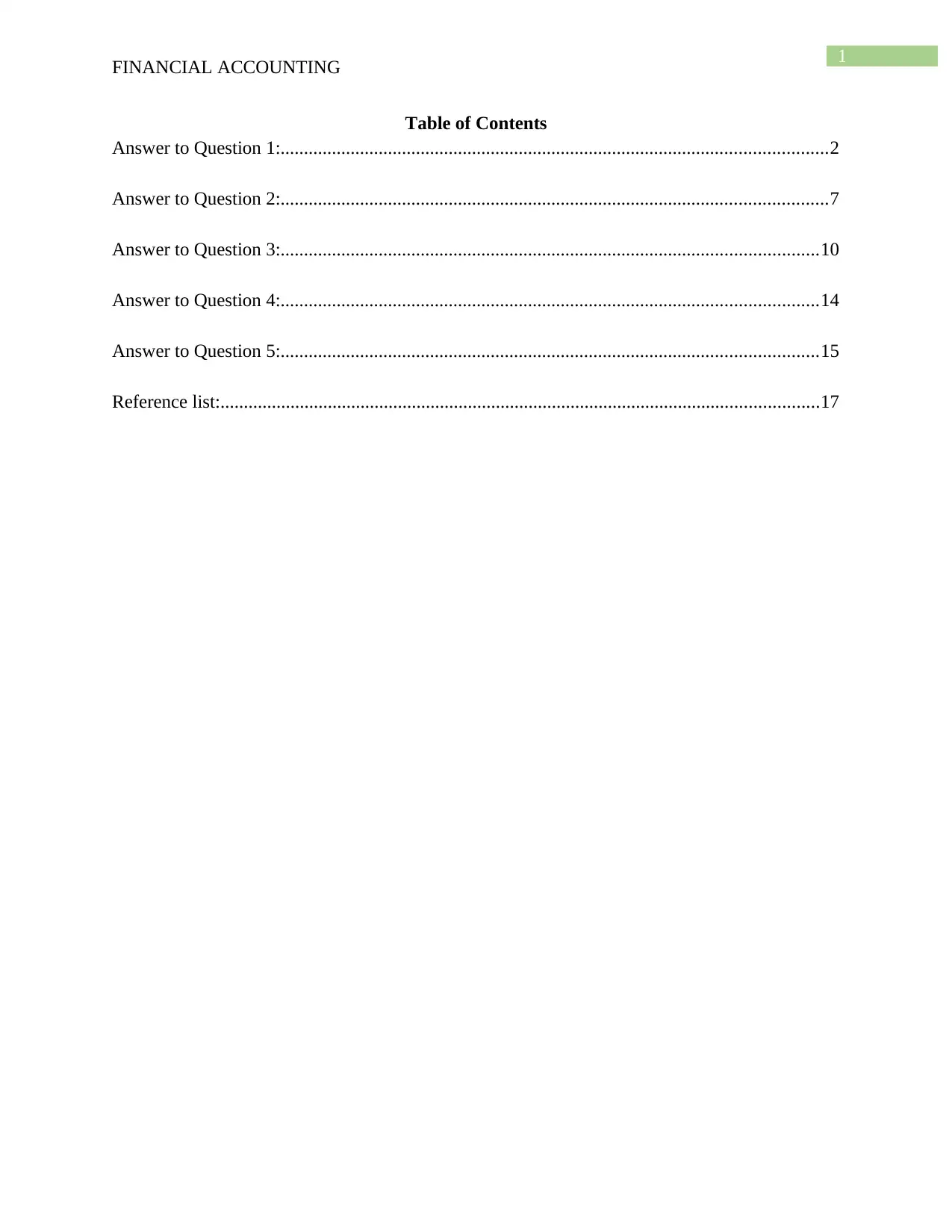
1
FINANCIAL ACCOUNTING
Table of Contents
Answer to Question 1:.....................................................................................................................2
Answer to Question 2:.....................................................................................................................7
Answer to Question 3:...................................................................................................................10
Answer to Question 4:...................................................................................................................14
Answer to Question 5:...................................................................................................................15
Reference list:................................................................................................................................17
FINANCIAL ACCOUNTING
Table of Contents
Answer to Question 1:.....................................................................................................................2
Answer to Question 2:.....................................................................................................................7
Answer to Question 3:...................................................................................................................10
Answer to Question 4:...................................................................................................................14
Answer to Question 5:...................................................................................................................15
Reference list:................................................................................................................................17

2
FINANCIAL ACCOUNTING
Answer to Question 1:
To,
Chairperson
International standard accounting board (IASB)
30 cannon street, London- EC4M 6XH, United Kingdom
Date: 3rd March, 2018
Subject: To provide feedback and recommendation on principles of effective communication
Sir,
I have been planning to make investment in two selected organizations
listed on the Australian stock exchange that is Common wealth bank (CBA) and National
Australia bank (NAB). I have viewed the notes disclosure by comparing and reviewing the
annual report of both organizations and in lieu of that, I have planned to make submission of my
response through this report. The disclosure of financial statements are faced with some of the
concerns such as prevalence of irrelevant information in the notes, insufficient information in the
notes and existence of ineffective communication on the information provided. The disclosure
issues are intended to be addressed by the board by releasing of discussion paper that is
Disclosure Initiative- Principles of disclosures. Such paper has been released for improving the
communication in the financial report. Financial statement prepares finds it difficult and complex
to report the information from the annual report to the external users and therefore, it is
perceived by the investors that the information displayed in the annual report is not relevant and
FINANCIAL ACCOUNTING
Answer to Question 1:
To,
Chairperson
International standard accounting board (IASB)
30 cannon street, London- EC4M 6XH, United Kingdom
Date: 3rd March, 2018
Subject: To provide feedback and recommendation on principles of effective communication
Sir,
I have been planning to make investment in two selected organizations
listed on the Australian stock exchange that is Common wealth bank (CBA) and National
Australia bank (NAB). I have viewed the notes disclosure by comparing and reviewing the
annual report of both organizations and in lieu of that, I have planned to make submission of my
response through this report. The disclosure of financial statements are faced with some of the
concerns such as prevalence of irrelevant information in the notes, insufficient information in the
notes and existence of ineffective communication on the information provided. The disclosure
issues are intended to be addressed by the board by releasing of discussion paper that is
Disclosure Initiative- Principles of disclosures. Such paper has been released for improving the
communication in the financial report. Financial statement prepares finds it difficult and complex
to report the information from the annual report to the external users and therefore, it is
perceived by the investors that the information displayed in the annual report is not relevant and
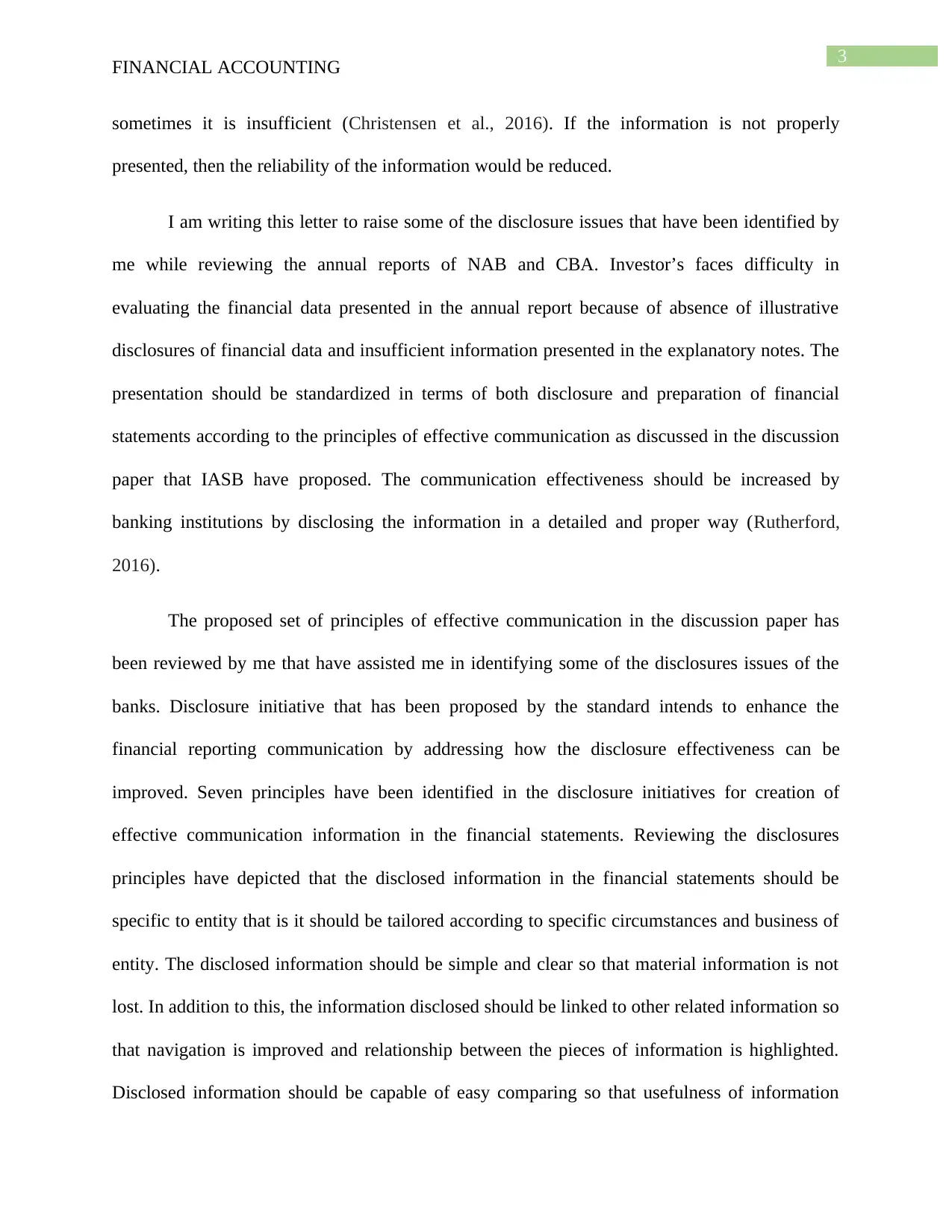
3
FINANCIAL ACCOUNTING
sometimes it is insufficient (Christensen et al., 2016). If the information is not properly
presented, then the reliability of the information would be reduced.
I am writing this letter to raise some of the disclosure issues that have been identified by
me while reviewing the annual reports of NAB and CBA. Investor’s faces difficulty in
evaluating the financial data presented in the annual report because of absence of illustrative
disclosures of financial data and insufficient information presented in the explanatory notes. The
presentation should be standardized in terms of both disclosure and preparation of financial
statements according to the principles of effective communication as discussed in the discussion
paper that IASB have proposed. The communication effectiveness should be increased by
banking institutions by disclosing the information in a detailed and proper way (Rutherford,
2016).
The proposed set of principles of effective communication in the discussion paper has
been reviewed by me that have assisted me in identifying some of the disclosures issues of the
banks. Disclosure initiative that has been proposed by the standard intends to enhance the
financial reporting communication by addressing how the disclosure effectiveness can be
improved. Seven principles have been identified in the disclosure initiatives for creation of
effective communication information in the financial statements. Reviewing the disclosures
principles have depicted that the disclosed information in the financial statements should be
specific to entity that is it should be tailored according to specific circumstances and business of
entity. The disclosed information should be simple and clear so that material information is not
lost. In addition to this, the information disclosed should be linked to other related information so
that navigation is improved and relationship between the pieces of information is highlighted.
Disclosed information should be capable of easy comparing so that usefulness of information
FINANCIAL ACCOUNTING
sometimes it is insufficient (Christensen et al., 2016). If the information is not properly
presented, then the reliability of the information would be reduced.
I am writing this letter to raise some of the disclosure issues that have been identified by
me while reviewing the annual reports of NAB and CBA. Investor’s faces difficulty in
evaluating the financial data presented in the annual report because of absence of illustrative
disclosures of financial data and insufficient information presented in the explanatory notes. The
presentation should be standardized in terms of both disclosure and preparation of financial
statements according to the principles of effective communication as discussed in the discussion
paper that IASB have proposed. The communication effectiveness should be increased by
banking institutions by disclosing the information in a detailed and proper way (Rutherford,
2016).
The proposed set of principles of effective communication in the discussion paper has
been reviewed by me that have assisted me in identifying some of the disclosures issues of the
banks. Disclosure initiative that has been proposed by the standard intends to enhance the
financial reporting communication by addressing how the disclosure effectiveness can be
improved. Seven principles have been identified in the disclosure initiatives for creation of
effective communication information in the financial statements. Reviewing the disclosures
principles have depicted that the disclosed information in the financial statements should be
specific to entity that is it should be tailored according to specific circumstances and business of
entity. The disclosed information should be simple and clear so that material information is not
lost. In addition to this, the information disclosed should be linked to other related information so
that navigation is improved and relationship between the pieces of information is highlighted.
Disclosed information should be capable of easy comparing so that usefulness of information
Secure Best Marks with AI Grader
Need help grading? Try our AI Grader for instant feedback on your assignments.
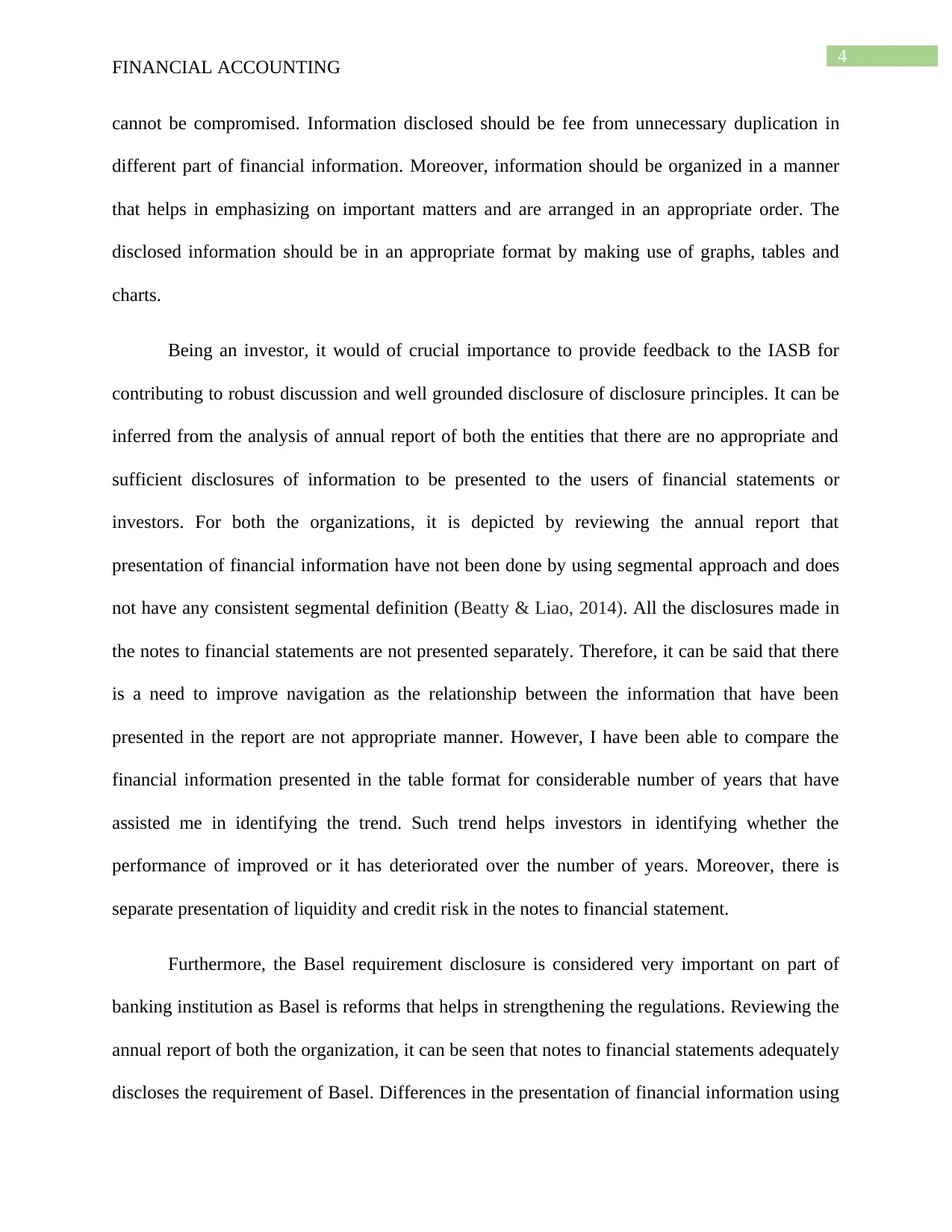
4
FINANCIAL ACCOUNTING
cannot be compromised. Information disclosed should be fee from unnecessary duplication in
different part of financial information. Moreover, information should be organized in a manner
that helps in emphasizing on important matters and are arranged in an appropriate order. The
disclosed information should be in an appropriate format by making use of graphs, tables and
charts.
Being an investor, it would of crucial importance to provide feedback to the IASB for
contributing to robust discussion and well grounded disclosure of disclosure principles. It can be
inferred from the analysis of annual report of both the entities that there are no appropriate and
sufficient disclosures of information to be presented to the users of financial statements or
investors. For both the organizations, it is depicted by reviewing the annual report that
presentation of financial information have not been done by using segmental approach and does
not have any consistent segmental definition (Beatty & Liao, 2014). All the disclosures made in
the notes to financial statements are not presented separately. Therefore, it can be said that there
is a need to improve navigation as the relationship between the information that have been
presented in the report are not appropriate manner. However, I have been able to compare the
financial information presented in the table format for considerable number of years that have
assisted me in identifying the trend. Such trend helps investors in identifying whether the
performance of improved or it has deteriorated over the number of years. Moreover, there is
separate presentation of liquidity and credit risk in the notes to financial statement.
Furthermore, the Basel requirement disclosure is considered very important on part of
banking institution as Basel is reforms that helps in strengthening the regulations. Reviewing the
annual report of both the organization, it can be seen that notes to financial statements adequately
discloses the requirement of Basel. Differences in the presentation of financial information using
FINANCIAL ACCOUNTING
cannot be compromised. Information disclosed should be fee from unnecessary duplication in
different part of financial information. Moreover, information should be organized in a manner
that helps in emphasizing on important matters and are arranged in an appropriate order. The
disclosed information should be in an appropriate format by making use of graphs, tables and
charts.
Being an investor, it would of crucial importance to provide feedback to the IASB for
contributing to robust discussion and well grounded disclosure of disclosure principles. It can be
inferred from the analysis of annual report of both the entities that there are no appropriate and
sufficient disclosures of information to be presented to the users of financial statements or
investors. For both the organizations, it is depicted by reviewing the annual report that
presentation of financial information have not been done by using segmental approach and does
not have any consistent segmental definition (Beatty & Liao, 2014). All the disclosures made in
the notes to financial statements are not presented separately. Therefore, it can be said that there
is a need to improve navigation as the relationship between the information that have been
presented in the report are not appropriate manner. However, I have been able to compare the
financial information presented in the table format for considerable number of years that have
assisted me in identifying the trend. Such trend helps investors in identifying whether the
performance of improved or it has deteriorated over the number of years. Moreover, there is
separate presentation of liquidity and credit risk in the notes to financial statement.
Furthermore, the Basel requirement disclosure is considered very important on part of
banking institution as Basel is reforms that helps in strengthening the regulations. Reviewing the
annual report of both the organization, it can be seen that notes to financial statements adequately
discloses the requirement of Basel. Differences in the presentation of financial information using
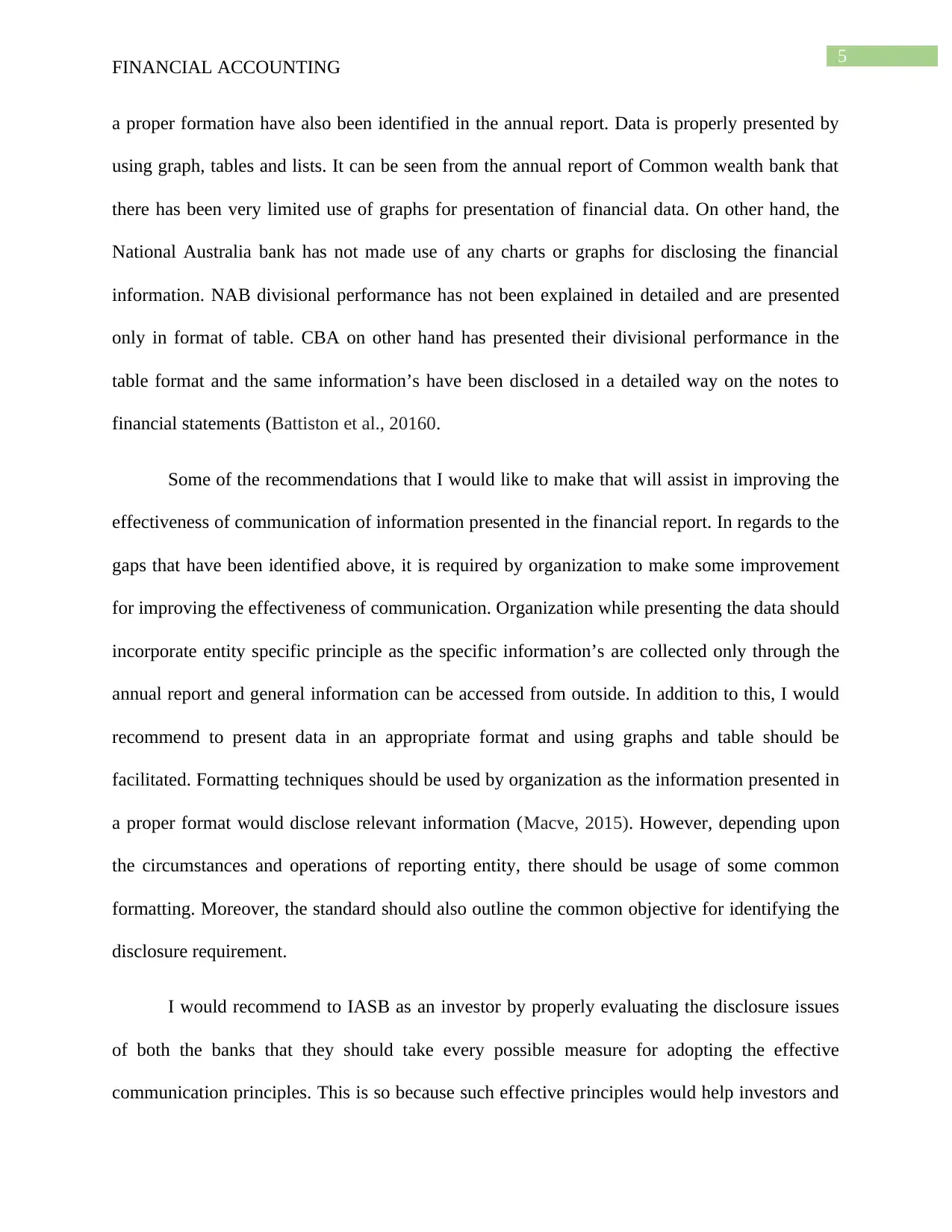
5
FINANCIAL ACCOUNTING
a proper formation have also been identified in the annual report. Data is properly presented by
using graph, tables and lists. It can be seen from the annual report of Common wealth bank that
there has been very limited use of graphs for presentation of financial data. On other hand, the
National Australia bank has not made use of any charts or graphs for disclosing the financial
information. NAB divisional performance has not been explained in detailed and are presented
only in format of table. CBA on other hand has presented their divisional performance in the
table format and the same information’s have been disclosed in a detailed way on the notes to
financial statements (Battiston et al., 20160.
Some of the recommendations that I would like to make that will assist in improving the
effectiveness of communication of information presented in the financial report. In regards to the
gaps that have been identified above, it is required by organization to make some improvement
for improving the effectiveness of communication. Organization while presenting the data should
incorporate entity specific principle as the specific information’s are collected only through the
annual report and general information can be accessed from outside. In addition to this, I would
recommend to present data in an appropriate format and using graphs and table should be
facilitated. Formatting techniques should be used by organization as the information presented in
a proper format would disclose relevant information (Macve, 2015). However, depending upon
the circumstances and operations of reporting entity, there should be usage of some common
formatting. Moreover, the standard should also outline the common objective for identifying the
disclosure requirement.
I would recommend to IASB as an investor by properly evaluating the disclosure issues
of both the banks that they should take every possible measure for adopting the effective
communication principles. This is so because such effective principles would help investors and
FINANCIAL ACCOUNTING
a proper formation have also been identified in the annual report. Data is properly presented by
using graph, tables and lists. It can be seen from the annual report of Common wealth bank that
there has been very limited use of graphs for presentation of financial data. On other hand, the
National Australia bank has not made use of any charts or graphs for disclosing the financial
information. NAB divisional performance has not been explained in detailed and are presented
only in format of table. CBA on other hand has presented their divisional performance in the
table format and the same information’s have been disclosed in a detailed way on the notes to
financial statements (Battiston et al., 20160.
Some of the recommendations that I would like to make that will assist in improving the
effectiveness of communication of information presented in the financial report. In regards to the
gaps that have been identified above, it is required by organization to make some improvement
for improving the effectiveness of communication. Organization while presenting the data should
incorporate entity specific principle as the specific information’s are collected only through the
annual report and general information can be accessed from outside. In addition to this, I would
recommend to present data in an appropriate format and using graphs and table should be
facilitated. Formatting techniques should be used by organization as the information presented in
a proper format would disclose relevant information (Macve, 2015). However, depending upon
the circumstances and operations of reporting entity, there should be usage of some common
formatting. Moreover, the standard should also outline the common objective for identifying the
disclosure requirement.
I would recommend to IASB as an investor by properly evaluating the disclosure issues
of both the banks that they should take every possible measure for adopting the effective
communication principles. This is so because such effective principles would help investors and
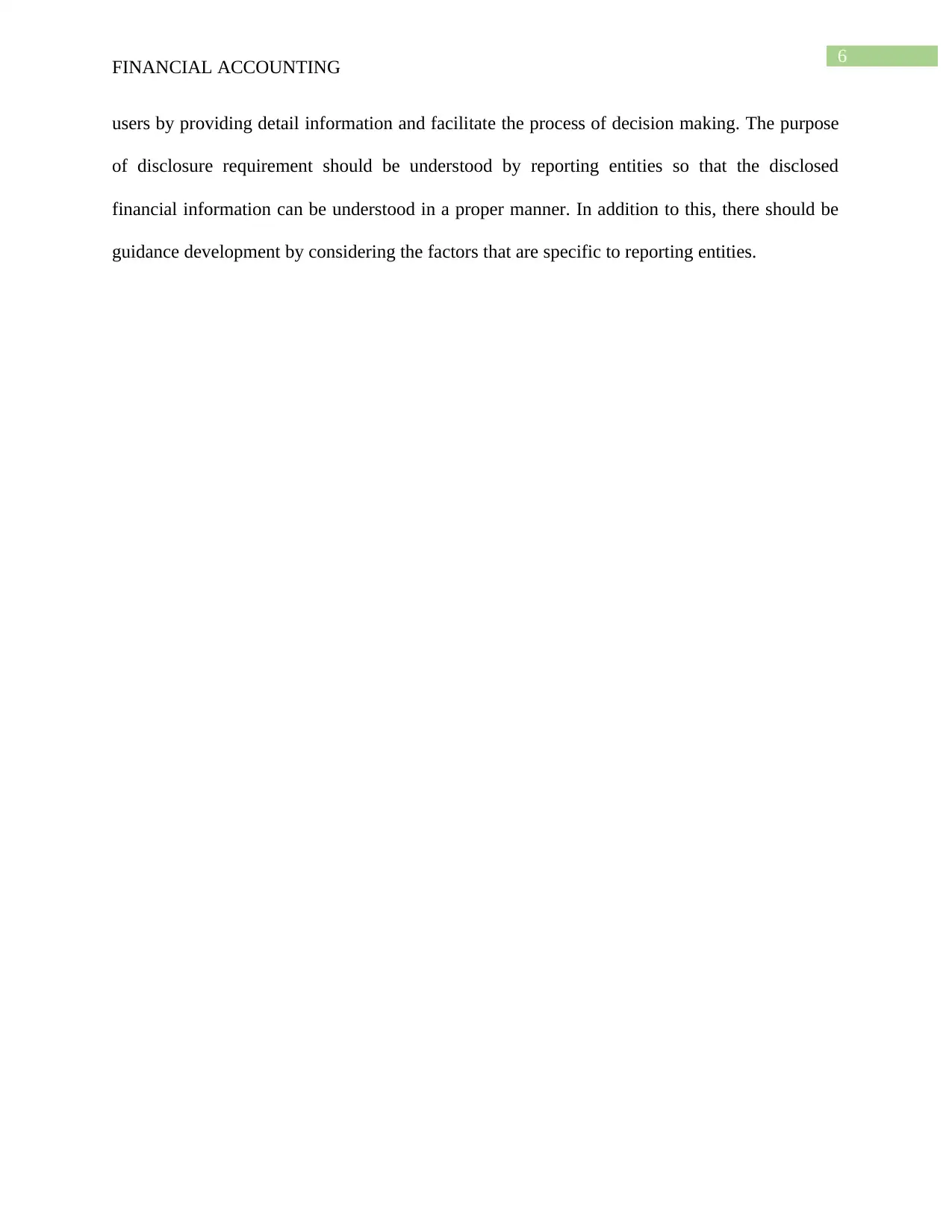
6
FINANCIAL ACCOUNTING
users by providing detail information and facilitate the process of decision making. The purpose
of disclosure requirement should be understood by reporting entities so that the disclosed
financial information can be understood in a proper manner. In addition to this, there should be
guidance development by considering the factors that are specific to reporting entities.
FINANCIAL ACCOUNTING
users by providing detail information and facilitate the process of decision making. The purpose
of disclosure requirement should be understood by reporting entities so that the disclosed
financial information can be understood in a proper manner. In addition to this, there should be
guidance development by considering the factors that are specific to reporting entities.
Paraphrase This Document
Need a fresh take? Get an instant paraphrase of this document with our AI Paraphraser
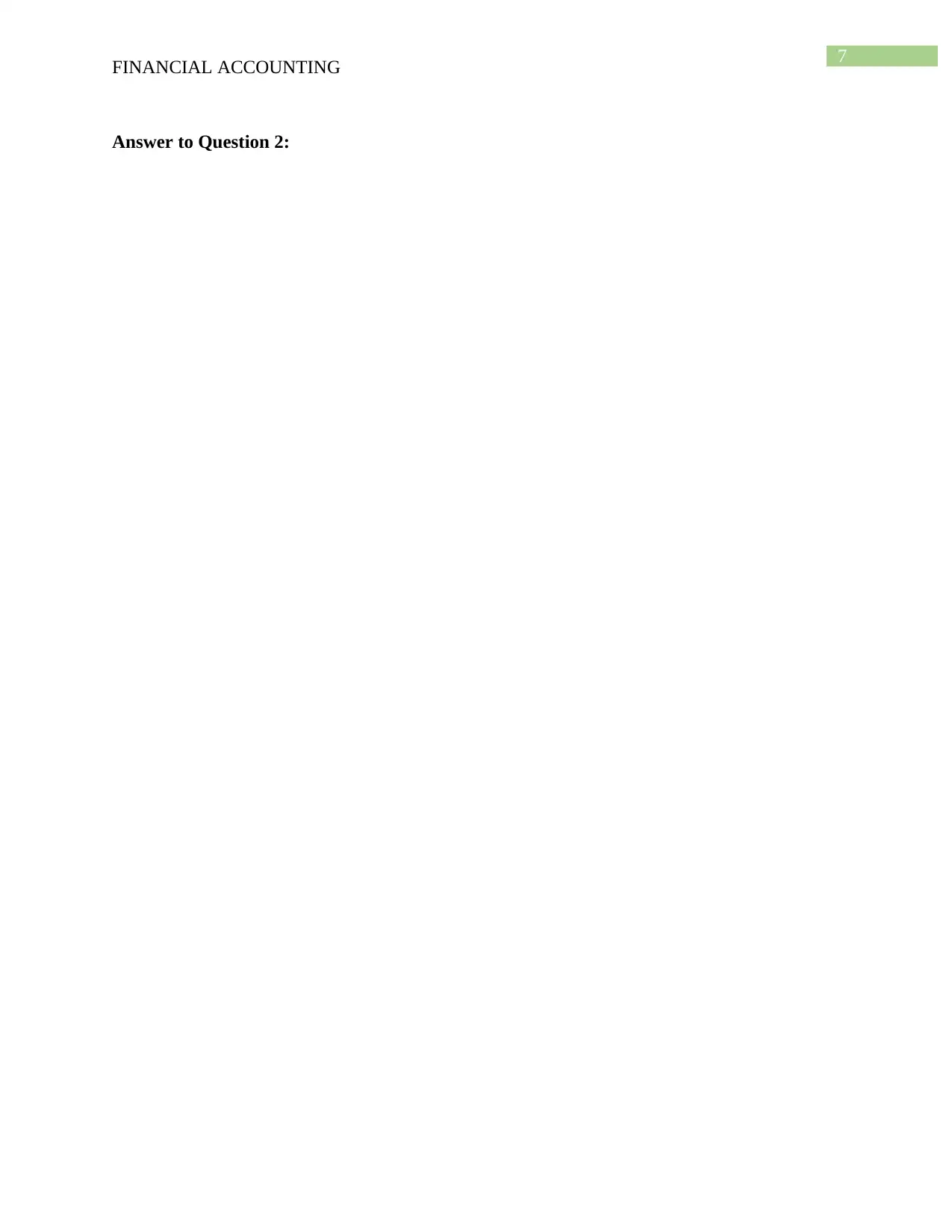
7
FINANCIAL ACCOUNTING
Answer to Question 2:
FINANCIAL ACCOUNTING
Answer to Question 2:
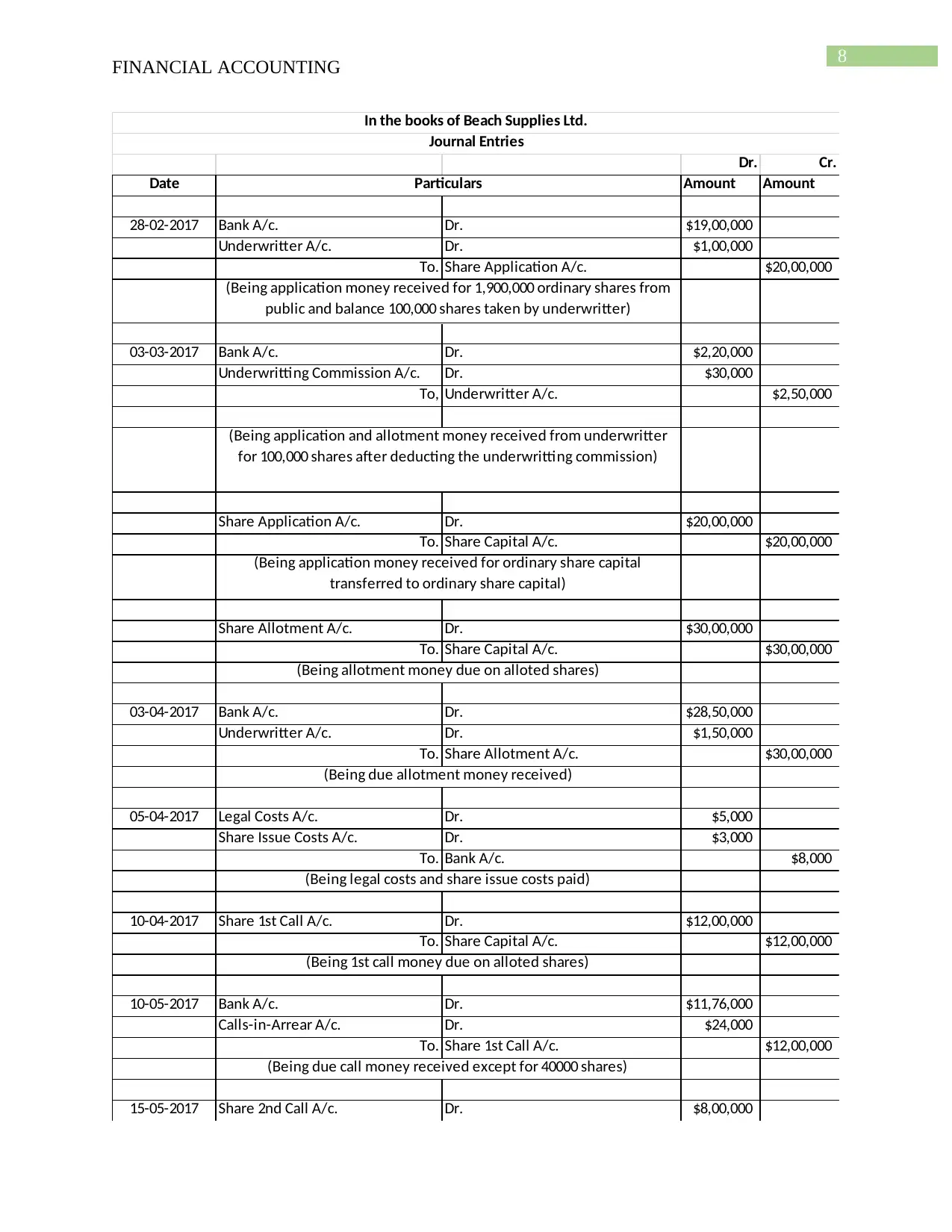
8
FINANCIAL ACCOUNTING
Dr. Cr.
Date Amount Amount
28-02-2017 Bank A/c. Dr. $19,00,000
Underwritter A/c. Dr. $1,00,000
To. Share Application A/c. $20,00,000
03-03-2017 Bank A/c. Dr. $2,20,000
Underwritting Commission A/c. Dr. $30,000
To, Underwritter A/c. $2,50,000
Share Application A/c. Dr. $20,00,000
To. Share Capital A/c. $20,00,000
Share Allotment A/c. Dr. $30,00,000
To. Share Capital A/c. $30,00,000
03-04-2017 Bank A/c. Dr. $28,50,000
Underwritter A/c. Dr. $1,50,000
To. Share Allotment A/c. $30,00,000
05-04-2017 Legal Costs A/c. Dr. $5,000
Share Issue Costs A/c. Dr. $3,000
To. Bank A/c. $8,000
10-04-2017 Share 1st Call A/c. Dr. $12,00,000
To. Share Capital A/c. $12,00,000
10-05-2017 Bank A/c. Dr. $11,76,000
Calls-in-Arrear A/c. Dr. $24,000
To. Share 1st Call A/c. $12,00,000
15-05-2017 Share 2nd Call A/c. Dr. $8,00,000
Particulars
(Being application money received for 1,900,000 ordinary shares from
public and balance 100,000 shares taken by underwritter)
(Being application and allotment money received from underwritter
for 100,000 shares after deducting the underwritting commission)
(Being application money received for ordinary share capital
transferred to ordinary share capital)
(Being allotment money due on alloted shares)
(Being due allotment money received)
(Being 1st call money due on alloted shares)
(Being due call money received except for 40000 shares)
(Being legal costs and share issue costs paid)
In the books of Beach Supplies Ltd.
Journal Entries
FINANCIAL ACCOUNTING
Dr. Cr.
Date Amount Amount
28-02-2017 Bank A/c. Dr. $19,00,000
Underwritter A/c. Dr. $1,00,000
To. Share Application A/c. $20,00,000
03-03-2017 Bank A/c. Dr. $2,20,000
Underwritting Commission A/c. Dr. $30,000
To, Underwritter A/c. $2,50,000
Share Application A/c. Dr. $20,00,000
To. Share Capital A/c. $20,00,000
Share Allotment A/c. Dr. $30,00,000
To. Share Capital A/c. $30,00,000
03-04-2017 Bank A/c. Dr. $28,50,000
Underwritter A/c. Dr. $1,50,000
To. Share Allotment A/c. $30,00,000
05-04-2017 Legal Costs A/c. Dr. $5,000
Share Issue Costs A/c. Dr. $3,000
To. Bank A/c. $8,000
10-04-2017 Share 1st Call A/c. Dr. $12,00,000
To. Share Capital A/c. $12,00,000
10-05-2017 Bank A/c. Dr. $11,76,000
Calls-in-Arrear A/c. Dr. $24,000
To. Share 1st Call A/c. $12,00,000
15-05-2017 Share 2nd Call A/c. Dr. $8,00,000
Particulars
(Being application money received for 1,900,000 ordinary shares from
public and balance 100,000 shares taken by underwritter)
(Being application and allotment money received from underwritter
for 100,000 shares after deducting the underwritting commission)
(Being application money received for ordinary share capital
transferred to ordinary share capital)
(Being allotment money due on alloted shares)
(Being due allotment money received)
(Being 1st call money due on alloted shares)
(Being due call money received except for 40000 shares)
(Being legal costs and share issue costs paid)
In the books of Beach Supplies Ltd.
Journal Entries
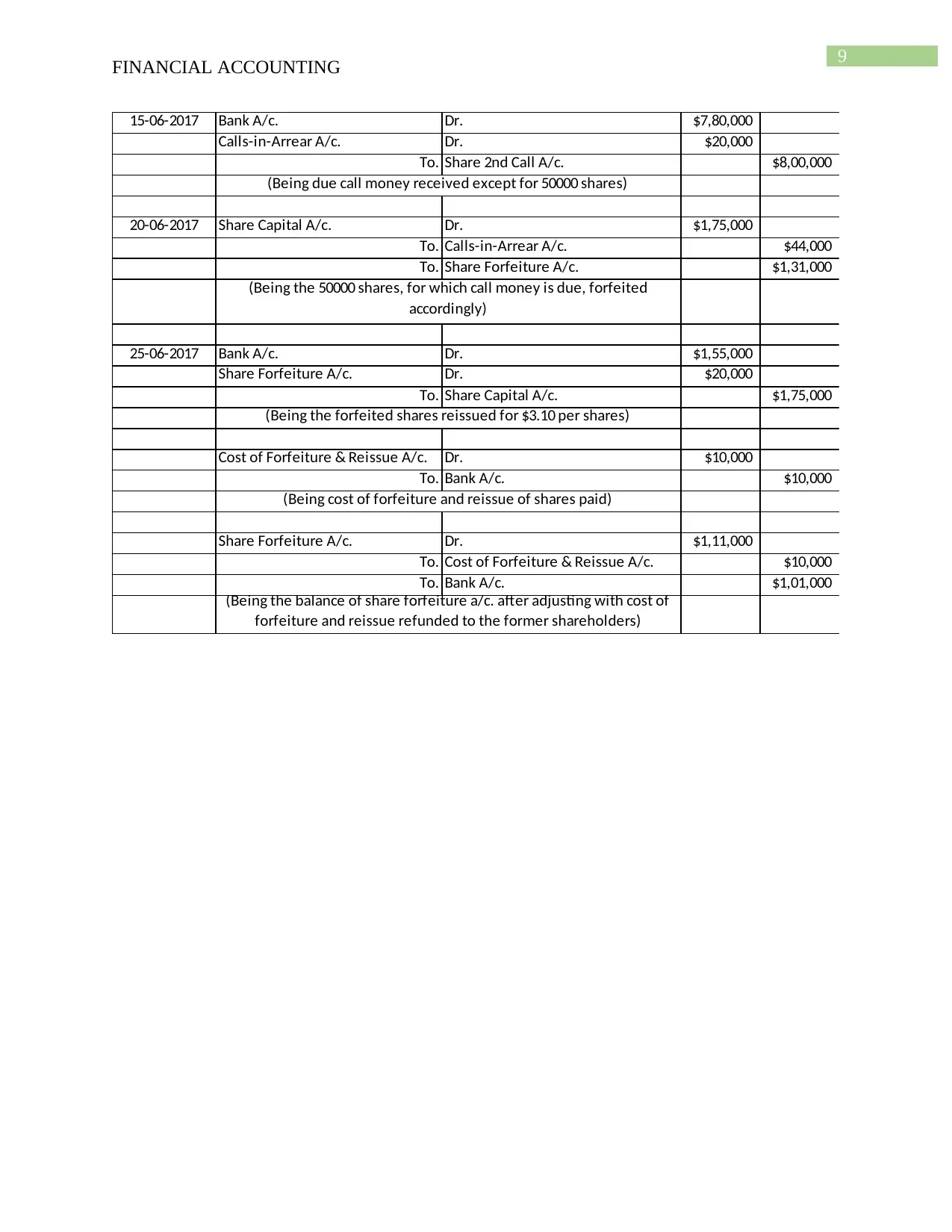
9
FINANCIAL ACCOUNTING
15-06-2017 Bank A/c. Dr. $7,80,000
Calls-in-Arrear A/c. Dr. $20,000
To. Share 2nd Call A/c. $8,00,000
20-06-2017 Share Capital A/c. Dr. $1,75,000
To. Calls-in-Arrear A/c. $44,000
To. Share Forfeiture A/c. $1,31,000
25-06-2017 Bank A/c. Dr. $1,55,000
Share Forfeiture A/c. Dr. $20,000
To. Share Capital A/c. $1,75,000
Cost of Forfeiture & Reissue A/c. Dr. $10,000
To. Bank A/c. $10,000
Share Forfeiture A/c. Dr. $1,11,000
To. Cost of Forfeiture & Reissue A/c. $10,000
To. Bank A/c. $1,01,000
(Being the balance of share forfeiture a/c. after adjusting with cost of
forfeiture and reissue refunded to the former shareholders)
(Being the 50000 shares, for which call money is due, forfeited
accordingly)
(Being the forfeited shares reissued for $3.10 per shares)
(Being cost of forfeiture and reissue of shares paid)
(Being due call money received except for 50000 shares)
FINANCIAL ACCOUNTING
15-06-2017 Bank A/c. Dr. $7,80,000
Calls-in-Arrear A/c. Dr. $20,000
To. Share 2nd Call A/c. $8,00,000
20-06-2017 Share Capital A/c. Dr. $1,75,000
To. Calls-in-Arrear A/c. $44,000
To. Share Forfeiture A/c. $1,31,000
25-06-2017 Bank A/c. Dr. $1,55,000
Share Forfeiture A/c. Dr. $20,000
To. Share Capital A/c. $1,75,000
Cost of Forfeiture & Reissue A/c. Dr. $10,000
To. Bank A/c. $10,000
Share Forfeiture A/c. Dr. $1,11,000
To. Cost of Forfeiture & Reissue A/c. $10,000
To. Bank A/c. $1,01,000
(Being the balance of share forfeiture a/c. after adjusting with cost of
forfeiture and reissue refunded to the former shareholders)
(Being the 50000 shares, for which call money is due, forfeited
accordingly)
(Being the forfeited shares reissued for $3.10 per shares)
(Being cost of forfeiture and reissue of shares paid)
(Being due call money received except for 50000 shares)
Secure Best Marks with AI Grader
Need help grading? Try our AI Grader for instant feedback on your assignments.
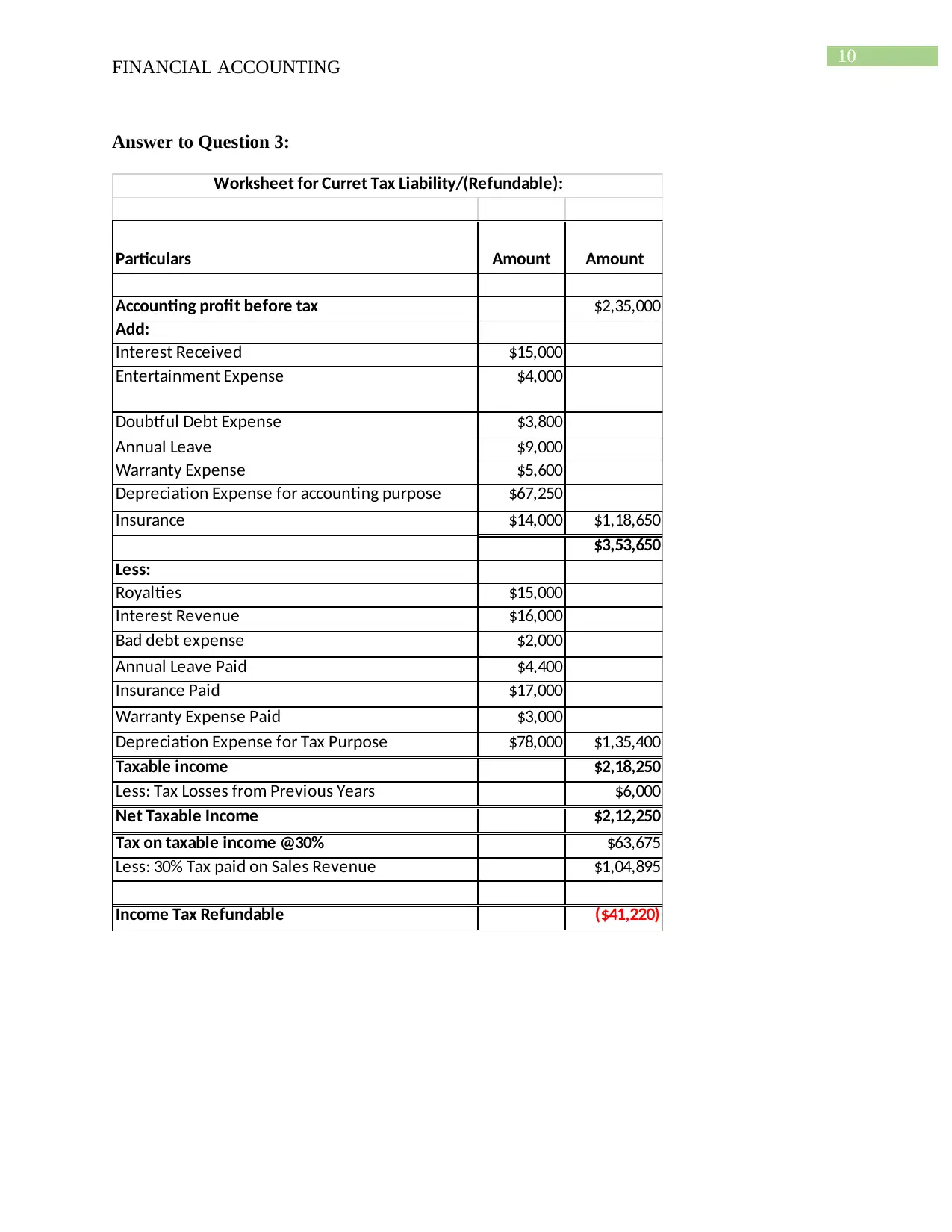
10
FINANCIAL ACCOUNTING
Answer to Question 3:
Particulars Amount Amount
Accounting profit before tax $2,35,000
Add:
Interest Received $15,000
Entertainment Expense $4,000
Doubtful Debt Expense $3,800
Annual Leave $9,000
Warranty Expense $5,600
Depreciation Expense for accounting purpose $67,250
Insurance $14,000 $1,18,650
$3,53,650
Less:
Royalties $15,000
Interest Revenue $16,000
Bad debt expense $2,000
Annual Leave Paid $4,400
Insurance Paid $17,000
Warranty Expense Paid $3,000
Depreciation Expense for Tax Purpose $78,000 $1,35,400
Taxable income $2,18,250
Less: Tax Losses from Previous Years $6,000
Net Taxable Income $2,12,250
Tax on taxable income @30% $63,675
Less: 30% Tax paid on Sales Revenue $1,04,895
Income Tax Refundable ($41,220)
Worksheet for Curret Tax Liability/(Refundable):
FINANCIAL ACCOUNTING
Answer to Question 3:
Particulars Amount Amount
Accounting profit before tax $2,35,000
Add:
Interest Received $15,000
Entertainment Expense $4,000
Doubtful Debt Expense $3,800
Annual Leave $9,000
Warranty Expense $5,600
Depreciation Expense for accounting purpose $67,250
Insurance $14,000 $1,18,650
$3,53,650
Less:
Royalties $15,000
Interest Revenue $16,000
Bad debt expense $2,000
Annual Leave Paid $4,400
Insurance Paid $17,000
Warranty Expense Paid $3,000
Depreciation Expense for Tax Purpose $78,000 $1,35,400
Taxable income $2,18,250
Less: Tax Losses from Previous Years $6,000
Net Taxable Income $2,12,250
Tax on taxable income @30% $63,675
Less: 30% Tax paid on Sales Revenue $1,04,895
Income Tax Refundable ($41,220)
Worksheet for Curret Tax Liability/(Refundable):
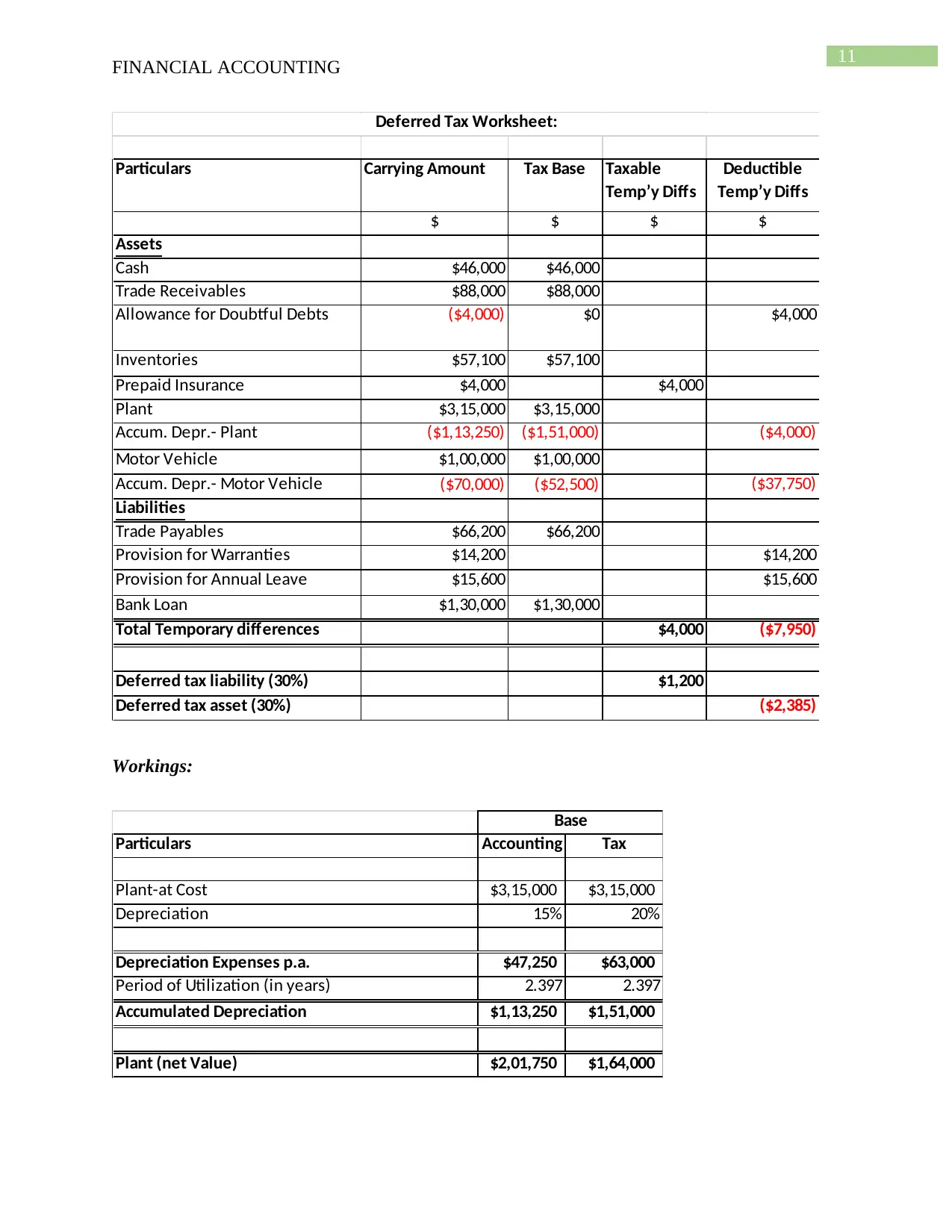
11
FINANCIAL ACCOUNTING
Particulars Carrying Amount Tax Base Taxable
Temp’y Diffs
Deductible
Temp’y Diffs
$ $ $ $
Assets
Cash $46,000 $46,000
Trade Receivables $88,000 $88,000
Allowance for Doubtful Debts ($4,000) $0 $4,000
Inventories $57,100 $57,100
Prepaid Insurance $4,000 $4,000
Plant $3,15,000 $3,15,000
Accum. Depr.- Plant ($1,13,250) ($1,51,000) ($4,000)
Motor Vehicle $1,00,000 $1,00,000
Accum. Depr.- Motor Vehicle ($70,000) ($52,500) ($37,750)
Liabilities
Trade Payables $66,200 $66,200
Provision for Warranties $14,200 $14,200
Provision for Annual Leave $15,600 $15,600
Bank Loan $1,30,000 $1,30,000
Total Temporary differences $4,000 ($7,950)
Deferred tax liability (30%) $1,200
Deferred tax asset (30%) ($2,385)
Deferred Tax Worksheet:
Workings:
Particulars Accounting Tax
Plant-at Cost $3,15,000 $3,15,000
Depreciation 15% 20%
Depreciation Expenses p.a. $47,250 $63,000
Period of Utilization (in years) 2.397 2.397
Accumulated Depreciation $1,13,250 $1,51,000
Plant (net Value) $2,01,750 $1,64,000
Base
FINANCIAL ACCOUNTING
Particulars Carrying Amount Tax Base Taxable
Temp’y Diffs
Deductible
Temp’y Diffs
$ $ $ $
Assets
Cash $46,000 $46,000
Trade Receivables $88,000 $88,000
Allowance for Doubtful Debts ($4,000) $0 $4,000
Inventories $57,100 $57,100
Prepaid Insurance $4,000 $4,000
Plant $3,15,000 $3,15,000
Accum. Depr.- Plant ($1,13,250) ($1,51,000) ($4,000)
Motor Vehicle $1,00,000 $1,00,000
Accum. Depr.- Motor Vehicle ($70,000) ($52,500) ($37,750)
Liabilities
Trade Payables $66,200 $66,200
Provision for Warranties $14,200 $14,200
Provision for Annual Leave $15,600 $15,600
Bank Loan $1,30,000 $1,30,000
Total Temporary differences $4,000 ($7,950)
Deferred tax liability (30%) $1,200
Deferred tax asset (30%) ($2,385)
Deferred Tax Worksheet:
Workings:
Particulars Accounting Tax
Plant-at Cost $3,15,000 $3,15,000
Depreciation 15% 20%
Depreciation Expenses p.a. $47,250 $63,000
Period of Utilization (in years) 2.397 2.397
Accumulated Depreciation $1,13,250 $1,51,000
Plant (net Value) $2,01,750 $1,64,000
Base
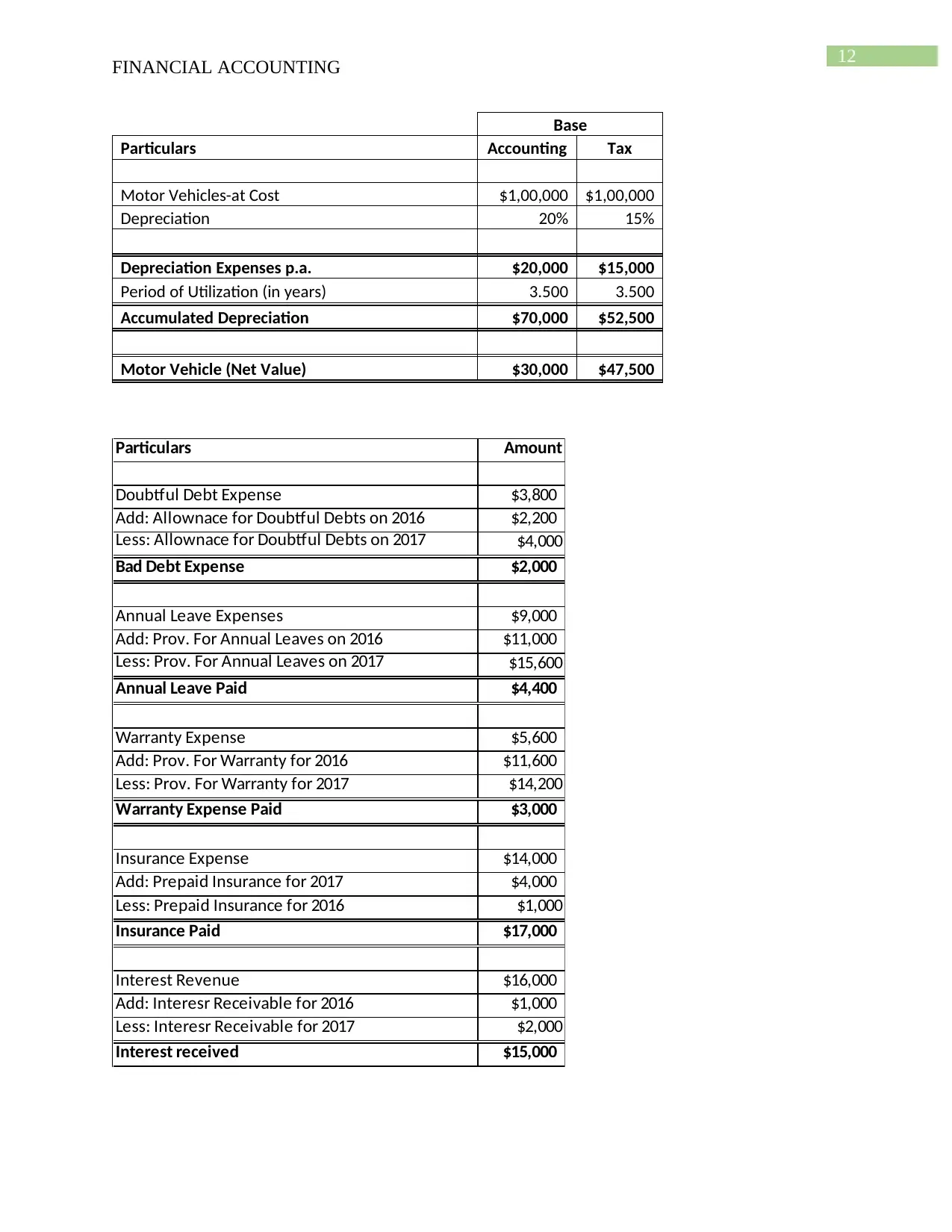
12
FINANCIAL ACCOUNTING
Base
Particulars Accounting Tax
Motor Vehicles-at Cost $1,00,000 $1,00,000
Depreciation 20% 15%
Depreciation Expenses p.a. $20,000 $15,000
Period of Utilization (in years) 3.500 3.500
Accumulated Depreciation $70,000 $52,500
Motor Vehicle (Net Value) $30,000 $47,500
Particulars Amount
Doubtful Debt Expense $3,800
Add: Allownace for Doubtful Debts on 2016 $2,200
Less: Allownace for Doubtful Debts on 2017 $4,000
Bad Debt Expense $2,000
Annual Leave Expenses $9,000
Add: Prov. For Annual Leaves on 2016 $11,000
Less: Prov. For Annual Leaves on 2017 $15,600
Annual Leave Paid $4,400
Warranty Expense $5,600
Add: Prov. For Warranty for 2016 $11,600
Less: Prov. For Warranty for 2017 $14,200
Warranty Expense Paid $3,000
Insurance Expense $14,000
Add: Prepaid Insurance for 2017 $4,000
Less: Prepaid Insurance for 2016 $1,000
Insurance Paid $17,000
Interest Revenue $16,000
Add: Interesr Receivable for 2016 $1,000
Less: Interesr Receivable for 2017 $2,000
Interest received $15,000
FINANCIAL ACCOUNTING
Base
Particulars Accounting Tax
Motor Vehicles-at Cost $1,00,000 $1,00,000
Depreciation 20% 15%
Depreciation Expenses p.a. $20,000 $15,000
Period of Utilization (in years) 3.500 3.500
Accumulated Depreciation $70,000 $52,500
Motor Vehicle (Net Value) $30,000 $47,500
Particulars Amount
Doubtful Debt Expense $3,800
Add: Allownace for Doubtful Debts on 2016 $2,200
Less: Allownace for Doubtful Debts on 2017 $4,000
Bad Debt Expense $2,000
Annual Leave Expenses $9,000
Add: Prov. For Annual Leaves on 2016 $11,000
Less: Prov. For Annual Leaves on 2017 $15,600
Annual Leave Paid $4,400
Warranty Expense $5,600
Add: Prov. For Warranty for 2016 $11,600
Less: Prov. For Warranty for 2017 $14,200
Warranty Expense Paid $3,000
Insurance Expense $14,000
Add: Prepaid Insurance for 2017 $4,000
Less: Prepaid Insurance for 2016 $1,000
Insurance Paid $17,000
Interest Revenue $16,000
Add: Interesr Receivable for 2016 $1,000
Less: Interesr Receivable for 2017 $2,000
Interest received $15,000
Paraphrase This Document
Need a fresh take? Get an instant paraphrase of this document with our AI Paraphraser
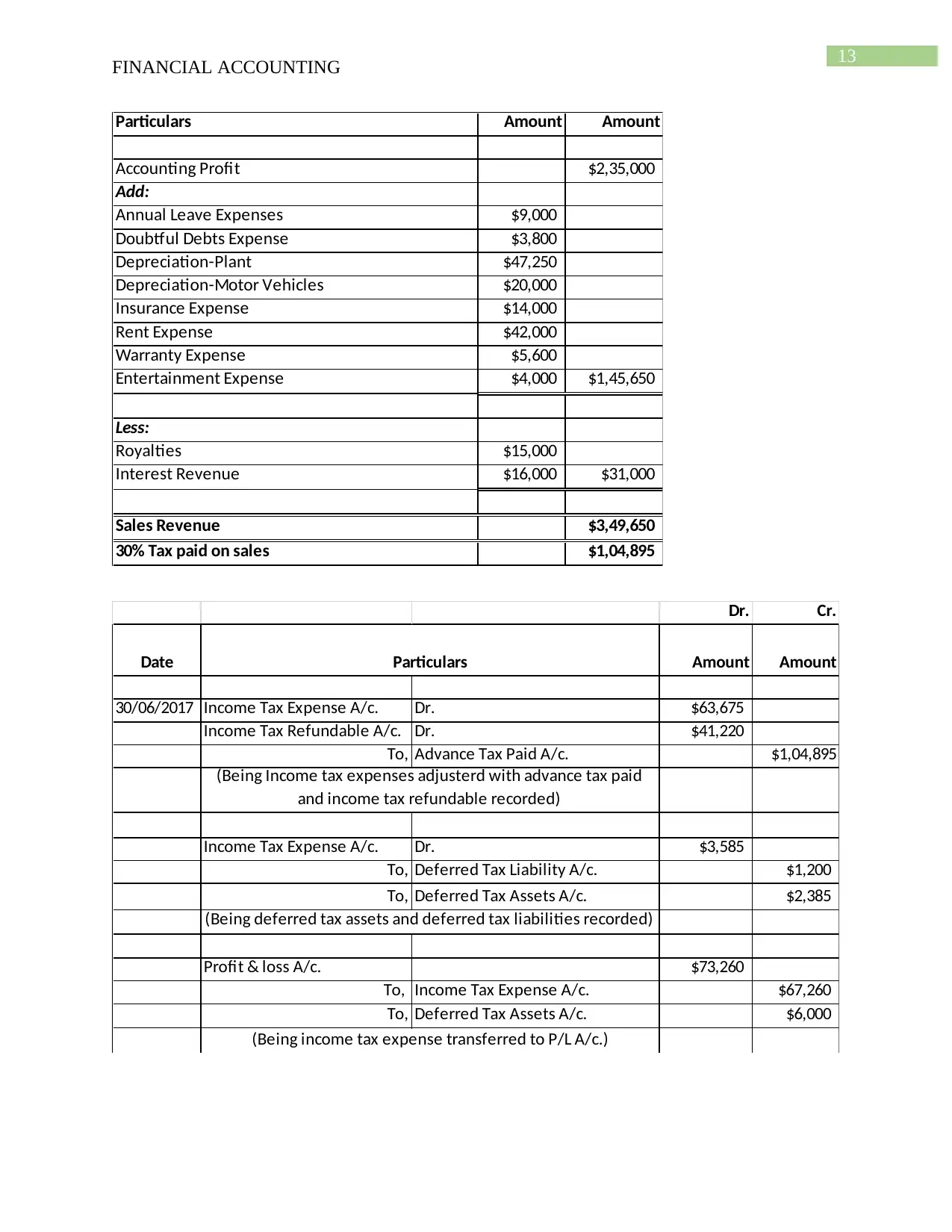
13
FINANCIAL ACCOUNTING
Particulars Amount Amount
Accounting Profit $2,35,000
Add:
Annual Leave Expenses $9,000
Doubtful Debts Expense $3,800
Depreciation-Plant $47,250
Depreciation-Motor Vehicles $20,000
Insurance Expense $14,000
Rent Expense $42,000
Warranty Expense $5,600
Entertainment Expense $4,000 $1,45,650
Less:
Royalties $15,000
Interest Revenue $16,000 $31,000
Sales Revenue $3,49,650
30% Tax paid on sales $1,04,895
Dr. Cr.
Date Amount Amount
30/06/2017 Income Tax Expense A/c. Dr. $63,675
Income Tax Refundable A/c. Dr. $41,220
To, Advance Tax Paid A/c. $1,04,895
Income Tax Expense A/c. Dr. $3,585
To, Deferred Tax Liability A/c. $1,200
To, Deferred Tax Assets A/c. $2,385
Profit & loss A/c. $73,260
To, Income Tax Expense A/c. $67,260
To, Deferred Tax Assets A/c. $6,000
(Being deferred tax assets and deferred tax liabilities recorded)
Particulars
(Being Income tax expenses adjusterd with advance tax paid
and income tax refundable recorded)
(Being income tax expense transferred to P/L A/c.)
FINANCIAL ACCOUNTING
Particulars Amount Amount
Accounting Profit $2,35,000
Add:
Annual Leave Expenses $9,000
Doubtful Debts Expense $3,800
Depreciation-Plant $47,250
Depreciation-Motor Vehicles $20,000
Insurance Expense $14,000
Rent Expense $42,000
Warranty Expense $5,600
Entertainment Expense $4,000 $1,45,650
Less:
Royalties $15,000
Interest Revenue $16,000 $31,000
Sales Revenue $3,49,650
30% Tax paid on sales $1,04,895
Dr. Cr.
Date Amount Amount
30/06/2017 Income Tax Expense A/c. Dr. $63,675
Income Tax Refundable A/c. Dr. $41,220
To, Advance Tax Paid A/c. $1,04,895
Income Tax Expense A/c. Dr. $3,585
To, Deferred Tax Liability A/c. $1,200
To, Deferred Tax Assets A/c. $2,385
Profit & loss A/c. $73,260
To, Income Tax Expense A/c. $67,260
To, Deferred Tax Assets A/c. $6,000
(Being deferred tax assets and deferred tax liabilities recorded)
Particulars
(Being Income tax expenses adjusterd with advance tax paid
and income tax refundable recorded)
(Being income tax expense transferred to P/L A/c.)
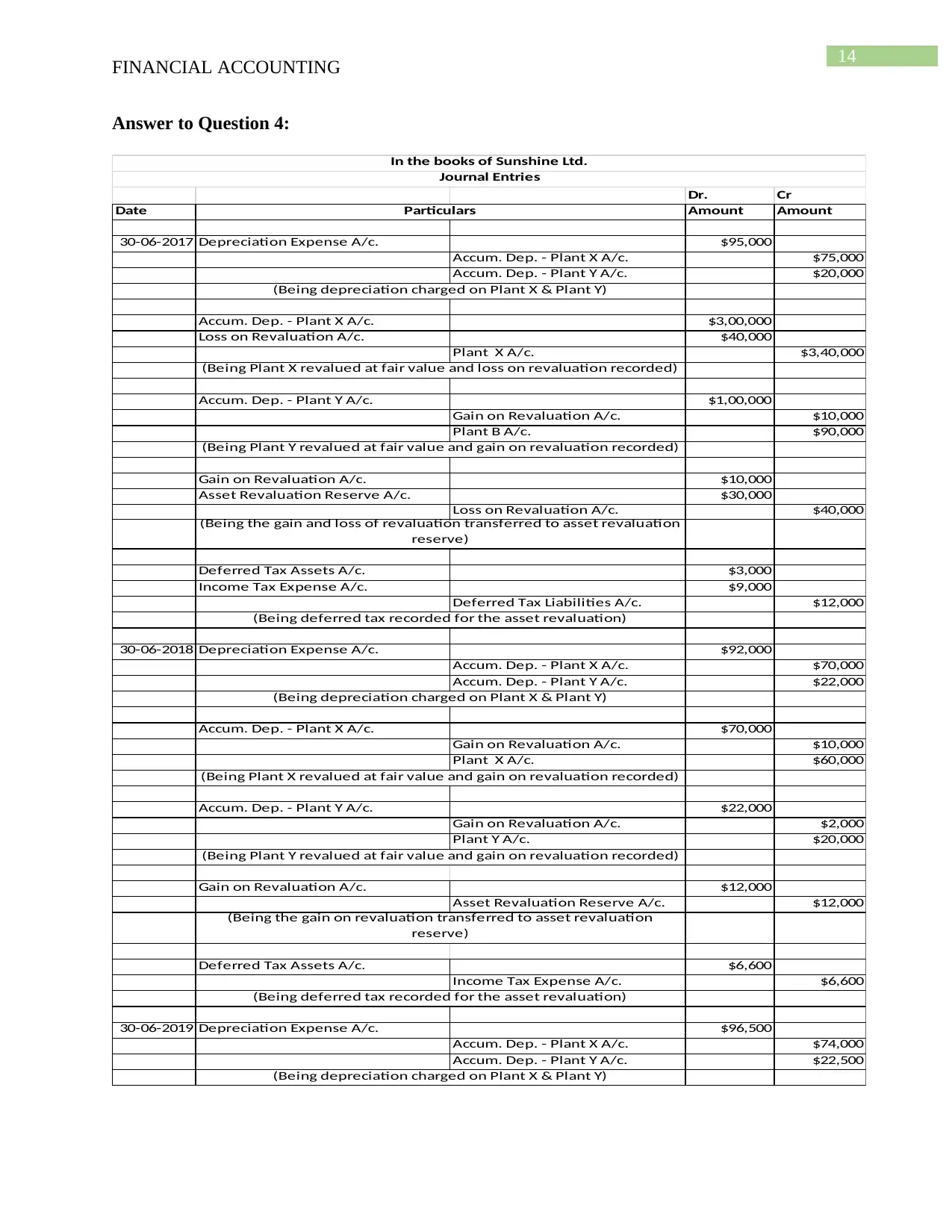
14
FINANCIAL ACCOUNTING
Answer to Question 4:
Dr. Cr
Date Amount Amount
30-06-2017 Depreciation Expense A/c. $95,000
Accum. Dep. - Plant X A/c. $75,000
Accum. Dep. - Plant Y A/c. $20,000
Accum. Dep. - Plant X A/c. $3,00,000
Loss on Revaluation A/c. $40,000
Plant X A/c. $3,40,000
Accum. Dep. - Plant Y A/c. $1,00,000
Gain on Revaluation A/c. $10,000
Plant B A/c. $90,000
Gain on Revaluation A/c. $10,000
Asset Revaluation Reserve A/c. $30,000
Loss on Revaluation A/c. $40,000
Deferred Tax Assets A/c. $3,000
Income Tax Expense A/c. $9,000
Deferred Tax Liabilities A/c. $12,000
30-06-2018 Depreciation Expense A/c. $92,000
Accum. Dep. - Plant X A/c. $70,000
Accum. Dep. - Plant Y A/c. $22,000
Accum. Dep. - Plant X A/c. $70,000
Gain on Revaluation A/c. $10,000
Plant X A/c. $60,000
Accum. Dep. - Plant Y A/c. $22,000
Gain on Revaluation A/c. $2,000
Plant Y A/c. $20,000
Gain on Revaluation A/c. $12,000
Asset Revaluation Reserve A/c. $12,000
Deferred Tax Assets A/c. $6,600
Income Tax Expense A/c. $6,600
30-06-2019 Depreciation Expense A/c. $96,500
Accum. Dep. - Plant X A/c. $74,000
Accum. Dep. - Plant Y A/c. $22,500
(Being depreciation charged on Plant X & Plant Y)
(Being Plant Y revalued at fair value and gain on revaluation recorded)
(Being the gain on revaluation transferred to asset revaluation
reserve)
(Being deferred tax recorded for the asset revaluation)
Journal Entries
(Being deferred tax recorded for the asset revaluation)
(Being depreciation charged on Plant X & Plant Y)
(Being depreciation charged on Plant X & Plant Y)
(Being Plant X revalued at fair value and loss on revaluation recorded)
(Being Plant Y revalued at fair value and gain on revaluation recorded)
(Being the gain and loss of revaluation transferred to asset revaluation
reserve)
(Being Plant X revalued at fair value and gain on revaluation recorded)
Particulars
In the books of Sunshine Ltd.
FINANCIAL ACCOUNTING
Answer to Question 4:
Dr. Cr
Date Amount Amount
30-06-2017 Depreciation Expense A/c. $95,000
Accum. Dep. - Plant X A/c. $75,000
Accum. Dep. - Plant Y A/c. $20,000
Accum. Dep. - Plant X A/c. $3,00,000
Loss on Revaluation A/c. $40,000
Plant X A/c. $3,40,000
Accum. Dep. - Plant Y A/c. $1,00,000
Gain on Revaluation A/c. $10,000
Plant B A/c. $90,000
Gain on Revaluation A/c. $10,000
Asset Revaluation Reserve A/c. $30,000
Loss on Revaluation A/c. $40,000
Deferred Tax Assets A/c. $3,000
Income Tax Expense A/c. $9,000
Deferred Tax Liabilities A/c. $12,000
30-06-2018 Depreciation Expense A/c. $92,000
Accum. Dep. - Plant X A/c. $70,000
Accum. Dep. - Plant Y A/c. $22,000
Accum. Dep. - Plant X A/c. $70,000
Gain on Revaluation A/c. $10,000
Plant X A/c. $60,000
Accum. Dep. - Plant Y A/c. $22,000
Gain on Revaluation A/c. $2,000
Plant Y A/c. $20,000
Gain on Revaluation A/c. $12,000
Asset Revaluation Reserve A/c. $12,000
Deferred Tax Assets A/c. $6,600
Income Tax Expense A/c. $6,600
30-06-2019 Depreciation Expense A/c. $96,500
Accum. Dep. - Plant X A/c. $74,000
Accum. Dep. - Plant Y A/c. $22,500
(Being depreciation charged on Plant X & Plant Y)
(Being Plant Y revalued at fair value and gain on revaluation recorded)
(Being the gain on revaluation transferred to asset revaluation
reserve)
(Being deferred tax recorded for the asset revaluation)
Journal Entries
(Being deferred tax recorded for the asset revaluation)
(Being depreciation charged on Plant X & Plant Y)
(Being depreciation charged on Plant X & Plant Y)
(Being Plant X revalued at fair value and loss on revaluation recorded)
(Being Plant Y revalued at fair value and gain on revaluation recorded)
(Being the gain and loss of revaluation transferred to asset revaluation
reserve)
(Being Plant X revalued at fair value and gain on revaluation recorded)
Particulars
In the books of Sunshine Ltd.
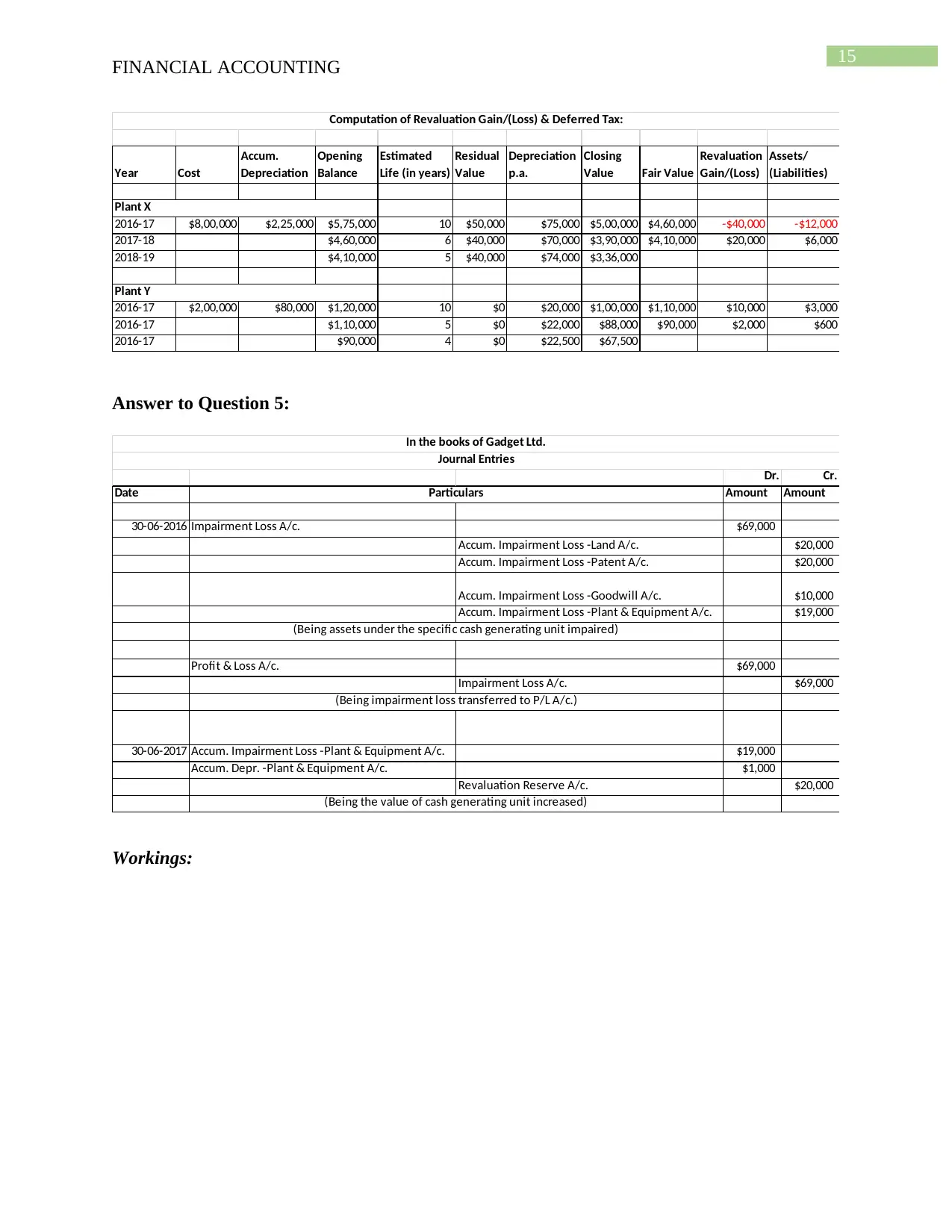
15
FINANCIAL ACCOUNTING
Year Cost
Accum.
Depreciation
Opening
Balance
Estimated
Life (in years)
Residual
Value
Depreciation
p.a.
Closing
Value Fair Value
Revaluation
Gain/(Loss)
Deferred Tax
Assets/
(Liabilities)
2016-17 $8,00,000 $2,25,000 $5,75,000 10 $50,000 $75,000 $5,00,000 $4,60,000 -$40,000 -$12,000
2017-18 $4,60,000 6 $40,000 $70,000 $3,90,000 $4,10,000 $20,000 $6,000
2018-19 $4,10,000 5 $40,000 $74,000 $3,36,000
2016-17 $2,00,000 $80,000 $1,20,000 10 $0 $20,000 $1,00,000 $1,10,000 $10,000 $3,000
2016-17 $1,10,000 5 $0 $22,000 $88,000 $90,000 $2,000 $600
2016-17 $90,000 4 $0 $22,500 $67,500
Plant X
Plant Y
Computation of Revaluation Gain/(Loss) & Deferred Tax:
Answer to Question 5:
Dr. Cr.
Date Amount Amount
30-06-2016 Impairment Loss A/c. $69,000
Accum. Impairment Loss -Land A/c. $20,000
Accum. Impairment Loss -Patent A/c. $20,000
Accum. Impairment Loss -Goodwill A/c. $10,000
Accum. Impairment Loss -Plant & Equipment A/c. $19,000
Profit & Loss A/c. $69,000
Impairment Loss A/c. $69,000
30-06-2017 Accum. Impairment Loss -Plant & Equipment A/c. $19,000
Accum. Depr. -Plant & Equipment A/c. $1,000
Revaluation Reserve A/c. $20,000
In the books of Gadget Ltd.
Journal Entries
Particulars
(Being assets under the specific cash generating unit impaired)
(Being impairment loss transferred to P/L A/c.)
(Being the value of cash generating unit increased)
Workings:
FINANCIAL ACCOUNTING
Year Cost
Accum.
Depreciation
Opening
Balance
Estimated
Life (in years)
Residual
Value
Depreciation
p.a.
Closing
Value Fair Value
Revaluation
Gain/(Loss)
Deferred Tax
Assets/
(Liabilities)
2016-17 $8,00,000 $2,25,000 $5,75,000 10 $50,000 $75,000 $5,00,000 $4,60,000 -$40,000 -$12,000
2017-18 $4,60,000 6 $40,000 $70,000 $3,90,000 $4,10,000 $20,000 $6,000
2018-19 $4,10,000 5 $40,000 $74,000 $3,36,000
2016-17 $2,00,000 $80,000 $1,20,000 10 $0 $20,000 $1,00,000 $1,10,000 $10,000 $3,000
2016-17 $1,10,000 5 $0 $22,000 $88,000 $90,000 $2,000 $600
2016-17 $90,000 4 $0 $22,500 $67,500
Plant X
Plant Y
Computation of Revaluation Gain/(Loss) & Deferred Tax:
Answer to Question 5:
Dr. Cr.
Date Amount Amount
30-06-2016 Impairment Loss A/c. $69,000
Accum. Impairment Loss -Land A/c. $20,000
Accum. Impairment Loss -Patent A/c. $20,000
Accum. Impairment Loss -Goodwill A/c. $10,000
Accum. Impairment Loss -Plant & Equipment A/c. $19,000
Profit & Loss A/c. $69,000
Impairment Loss A/c. $69,000
30-06-2017 Accum. Impairment Loss -Plant & Equipment A/c. $19,000
Accum. Depr. -Plant & Equipment A/c. $1,000
Revaluation Reserve A/c. $20,000
In the books of Gadget Ltd.
Journal Entries
Particulars
(Being assets under the specific cash generating unit impaired)
(Being impairment loss transferred to P/L A/c.)
(Being the value of cash generating unit increased)
Workings:
Secure Best Marks with AI Grader
Need help grading? Try our AI Grader for instant feedback on your assignments.
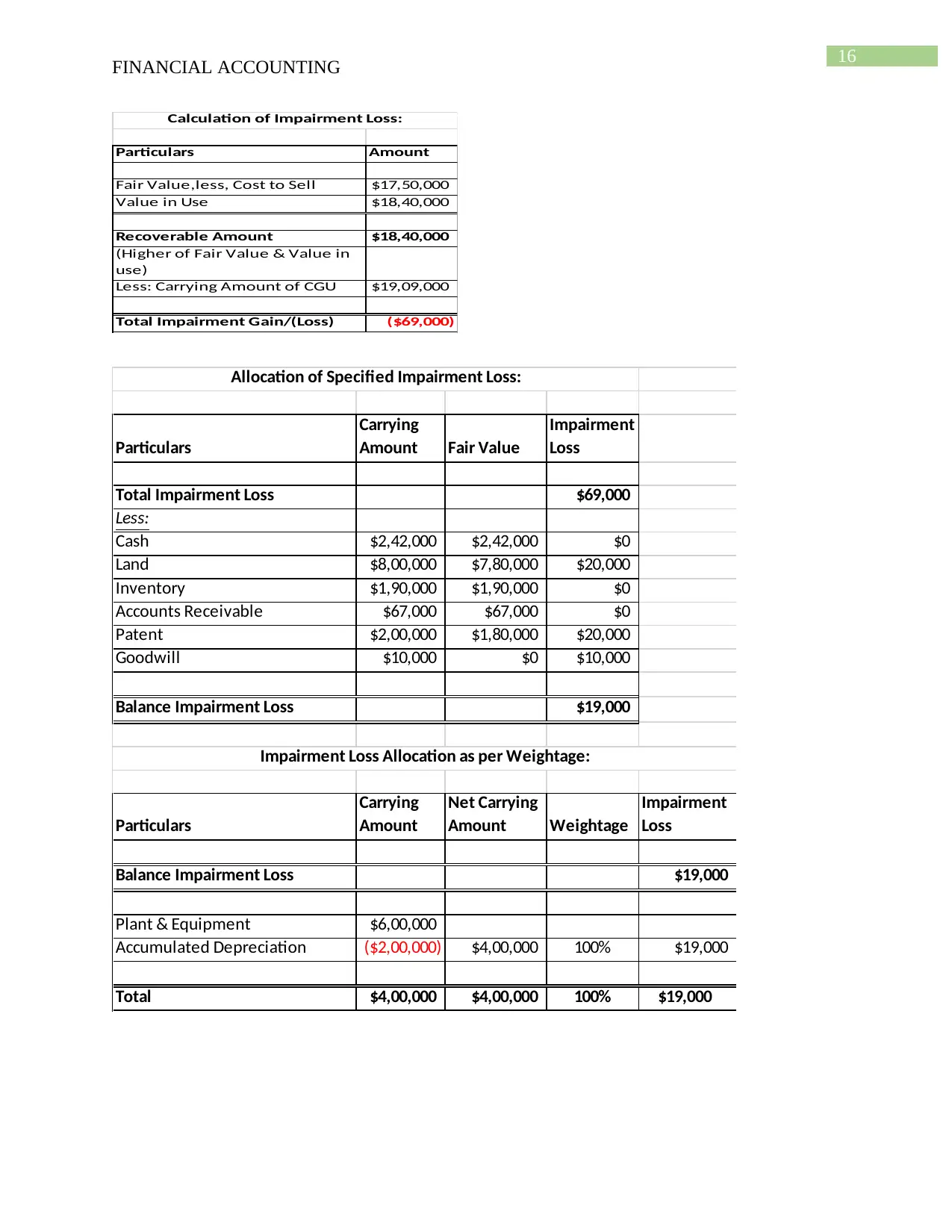
16
FINANCIAL ACCOUNTING
Particulars Amount
Fair Value,less, Cost to Sell $17,50,000
Value in Use $18,40,000
Recoverable Amount $18,40,000
(Higher of Fair Value & Value in
use)
Less: Carrying Amount of CGU $19,09,000
Total Impairment Gain/(Loss) ($69,000)
Calculation of Impairment Loss:
Particulars
Carrying
Amount Fair Value
Impairment
Loss
Total Impairment Loss $69,000
Less:
Cash $2,42,000 $2,42,000 $0
Land $8,00,000 $7,80,000 $20,000
Inventory $1,90,000 $1,90,000 $0
Accounts Receivable $67,000 $67,000 $0
Patent $2,00,000 $1,80,000 $20,000
Goodwill $10,000 $0 $10,000
Balance Impairment Loss $19,000
Particulars
Carrying
Amount
Net Carrying
Amount Weightage
Impairment
Loss
Balance Impairment Loss $19,000
Plant & Equipment $6,00,000
Accumulated Depreciation ($2,00,000) $4,00,000 100% $19,000
Total $4,00,000 $4,00,000 100% $19,000
Impairment Loss Allocation as per Weightage:
Allocation of Specified Impairment Loss:
FINANCIAL ACCOUNTING
Particulars Amount
Fair Value,less, Cost to Sell $17,50,000
Value in Use $18,40,000
Recoverable Amount $18,40,000
(Higher of Fair Value & Value in
use)
Less: Carrying Amount of CGU $19,09,000
Total Impairment Gain/(Loss) ($69,000)
Calculation of Impairment Loss:
Particulars
Carrying
Amount Fair Value
Impairment
Loss
Total Impairment Loss $69,000
Less:
Cash $2,42,000 $2,42,000 $0
Land $8,00,000 $7,80,000 $20,000
Inventory $1,90,000 $1,90,000 $0
Accounts Receivable $67,000 $67,000 $0
Patent $2,00,000 $1,80,000 $20,000
Goodwill $10,000 $0 $10,000
Balance Impairment Loss $19,000
Particulars
Carrying
Amount
Net Carrying
Amount Weightage
Impairment
Loss
Balance Impairment Loss $19,000
Plant & Equipment $6,00,000
Accumulated Depreciation ($2,00,000) $4,00,000 100% $19,000
Total $4,00,000 $4,00,000 100% $19,000
Impairment Loss Allocation as per Weightage:
Allocation of Specified Impairment Loss:
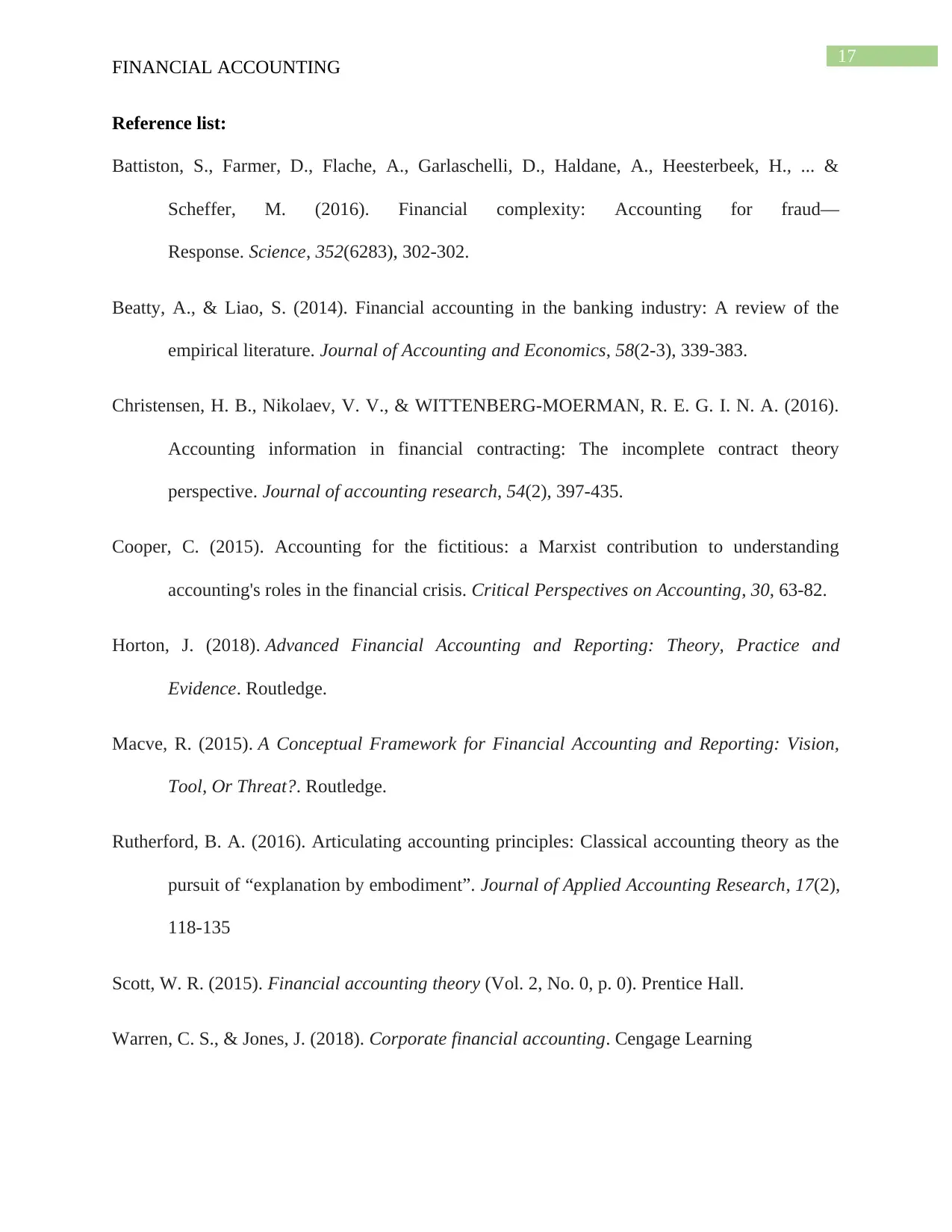
17
FINANCIAL ACCOUNTING
Reference list:
Battiston, S., Farmer, D., Flache, A., Garlaschelli, D., Haldane, A., Heesterbeek, H., ... &
Scheffer, M. (2016). Financial complexity: Accounting for fraud—
Response. Science, 352(6283), 302-302.
Beatty, A., & Liao, S. (2014). Financial accounting in the banking industry: A review of the
empirical literature. Journal of Accounting and Economics, 58(2-3), 339-383.
Christensen, H. B., Nikolaev, V. V., & WITTENBERG‐MOERMAN, R. E. G. I. N. A. (2016).
Accounting information in financial contracting: The incomplete contract theory
perspective. Journal of accounting research, 54(2), 397-435.
Cooper, C. (2015). Accounting for the fictitious: a Marxist contribution to understanding
accounting's roles in the financial crisis. Critical Perspectives on Accounting, 30, 63-82.
Horton, J. (2018). Advanced Financial Accounting and Reporting: Theory, Practice and
Evidence. Routledge.
Macve, R. (2015). A Conceptual Framework for Financial Accounting and Reporting: Vision,
Tool, Or Threat?. Routledge.
Rutherford, B. A. (2016). Articulating accounting principles: Classical accounting theory as the
pursuit of “explanation by embodiment”. Journal of Applied Accounting Research, 17(2),
118-135
Scott, W. R. (2015). Financial accounting theory (Vol. 2, No. 0, p. 0). Prentice Hall.
Warren, C. S., & Jones, J. (2018). Corporate financial accounting. Cengage Learning
FINANCIAL ACCOUNTING
Reference list:
Battiston, S., Farmer, D., Flache, A., Garlaschelli, D., Haldane, A., Heesterbeek, H., ... &
Scheffer, M. (2016). Financial complexity: Accounting for fraud—
Response. Science, 352(6283), 302-302.
Beatty, A., & Liao, S. (2014). Financial accounting in the banking industry: A review of the
empirical literature. Journal of Accounting and Economics, 58(2-3), 339-383.
Christensen, H. B., Nikolaev, V. V., & WITTENBERG‐MOERMAN, R. E. G. I. N. A. (2016).
Accounting information in financial contracting: The incomplete contract theory
perspective. Journal of accounting research, 54(2), 397-435.
Cooper, C. (2015). Accounting for the fictitious: a Marxist contribution to understanding
accounting's roles in the financial crisis. Critical Perspectives on Accounting, 30, 63-82.
Horton, J. (2018). Advanced Financial Accounting and Reporting: Theory, Practice and
Evidence. Routledge.
Macve, R. (2015). A Conceptual Framework for Financial Accounting and Reporting: Vision,
Tool, Or Threat?. Routledge.
Rutherford, B. A. (2016). Articulating accounting principles: Classical accounting theory as the
pursuit of “explanation by embodiment”. Journal of Applied Accounting Research, 17(2),
118-135
Scott, W. R. (2015). Financial accounting theory (Vol. 2, No. 0, p. 0). Prentice Hall.
Warren, C. S., & Jones, J. (2018). Corporate financial accounting. Cengage Learning
1 out of 18
Related Documents
Your All-in-One AI-Powered Toolkit for Academic Success.
+13062052269
info@desklib.com
Available 24*7 on WhatsApp / Email
![[object Object]](/_next/static/media/star-bottom.7253800d.svg)
Unlock your academic potential
© 2024 | Zucol Services PVT LTD | All rights reserved.





